Fernie, British Columbia 作者: 来源: 发布时间:2021-12-01
I.Population and Area
-Area:
•City: 13.50 km2 (5.21 sq mi)
•Elevation: 1,010 m (3,314 ft)
-Population (2016):
•City: 5,249 (Ranked 692nd)
•Metro: 7,192
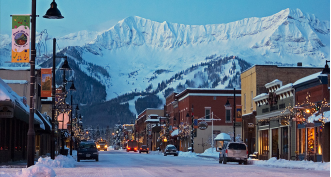
II.Natural Geography (environment and resources)
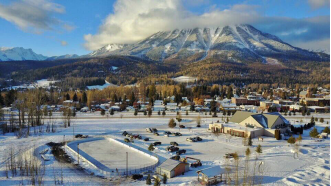
-Fernie is the only city-class municipality in Canada that is fully encircled by the Rocky Mountains. The townsite was laid out in the crook of a doglegged glacial valley that today is drained by the Elk River. Three tributaries of the Elk—Coal, Lizard, and Fairy Creeks—rise in its side valleys and join the Elk either within or in close proximity to the townsite.
-To the north of the city lie Mount Fernie, Mount Klauer, The Three Sisters and Mount Proctor. To the northeast is Mount Hosmer, to the east is Fernie Ridge, to the southeast is Morrissey Ridge (and its notable outcropping, Castle Mountain) and to the southwest are the various peaks of the Lizard Range. Fernie gives the name to the Jurassic-Age Fernie Formation. The Lizard Range is home to Fernie Alpine Resort, one of the largest ski resorts in Canada, and Island Lake Catskiing, a resort.
-Fernie is a city in the Elk Valley area of the East Kootenay region of southeastern British Columbia, Canada, located on BC Highway 3 on the eastern approaches to the Crowsnest Pass through the Rocky Mountains.
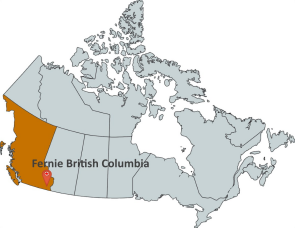
III.ECONOMY
-Fernie’s population grew 18% from 4,448 residents to 5,249 residents in the 2016 Census Canada results. Fernie’s diverse and buoyant economy, its proximity to the large mining operations (3% of Canada’s GDP) of Teck Resources, to the travel and tourism industries, to many home businesses and small offices and to the migrating professionals and active baby boomers have contributed to the city's growth.
-Fernie offers a rich heritage, a vibrant and growing cultural environment, a diverse network of winter and summer trails, ski slopes and cat ski operations, state-of-the-art fibre network infrastructures and good local shopping. The schools in Fernie (public elementary, public high school, French Immersion, Fernie Academy and a francophone school) attract families and offer superb educational choices for children, Proximity to three airports, Kalispell in Montana(FCA), Cranbrook(YXC) and Calgary(YYC) allows easy access to and from Canadian and American cities or international destinations for business or leisure travellers.
IV.Industrial Characteristics
-Fernie takes its name from William Fernie, who along with Colonel James Baker were the main players in the drive to bring coal mining to the valley. It took ten years to raise enough money to build the mines and the railway needed to transport the coal to market. In 1897 coal mining began in the region and in 1898 the Canadian Pacific Railroad arrived, and with it, the town of Fernie. As Fernie grew, logging quickly became the second largest industry in the area with logging camps employing hundreds of men.
-Fernie’s troubled history continued on into the depression of the thirties, when the city was brought to its knees and population and prosperity were reduced. Government subsidies kept the stagnant coal industry alive until the 1960s when it was revitalized by world coal markets. Today coal remains a pillar of Fernie’s economy.
-Business Infrastructure
•The City of Fernie knows how important economic growth and diversification are. This is why we have an Economic Development strategy that is geared towards making Fernie an attractive destination for new businesses and entrepreneurs, as well as a perfect location for established businesses to remain.
•Our strategy focuses on business retention, as well as investment in infrastructure and marketing of the City and region, in an effort to recruit new business.
V.Attractions
1.Fernie Alpine Resort
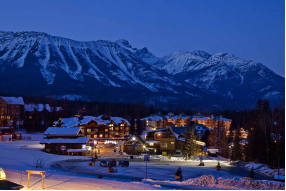
-Fernie Alpine Resort is a ski resort, located on Lizard Range, near the town of Fernie, British Columbia in Canada. It is known particularly for its high annual snowfall, reportedly the highest of any resort in the Canadian Rockies, and for its powder skiing. The resort also operates a mountain bike park, guided hikes, treetop aerial park, and zip line in the summer months.
-The resort has 10 lifts servicing 142 named runs plus 5 alpine bowls and tree skiing with a vertical drop of 1,082 meters (3,550 ft). The resort has over 10.1 square kilometres (2,500 acres) of skiable terrain. The average annual snowfall is 875 centimetres (28.71 ft).
-Fernie Alpine Resort is owned by Resorts of the Canadian Rockies which also owns ski areas, Kimberley Alpine Resort, Kicking Horse Resort, Nakiska, Mont Sainte-Anne, and Stoneham.
-Fernie Alpine Resort was originally called "Fernie Snow Valley" before being sold in 1997 to RCR (Resort of the Canadian Rockies). RCR saw some financial trouble under owner Charlie Locke, and after a period in bankruptcy protection, was bailed out by Alberta billionaire N. Murray Edwards.
-During spring 2009, Fernie Alpine Resort was transformed into the fictional Kodiak Valley ski resort, ca. 1986, for exterior location shots of the Hollywood film Hot Tub Time Machine. The film was released in March 2010.
2.Mount Fernie Provincial Park
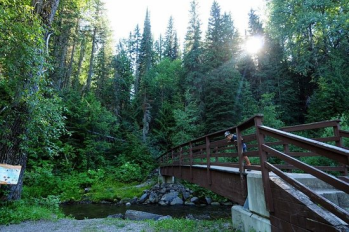
-Mount Fernie Provincial Park is a beautiful area with great and easy trails to go out and explore nature.
-Mt Fernie Provincial Park is accessible year-round, is close to town and offers seasonal camping/RVing. The 259 hectare park protects the sensitive flora and fauna in the park and the banks of Lizard Creek.
-There are multiple access points throughout the Park and to trails adjacent to the Park that connect with Mt Fernie, Island Lake Lodge and Fernie Alpine Resort for both hiking and mountain biking from late April to late October and is great for winter walks and snowshoeing between November and early April. As these trails are shared multi-use trails please remember to keep your head up and be mindful of your surroundings.
3.Fairy Creek Falls
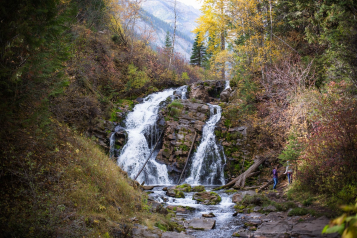
-The easy singletrack trail to Fairy Creek Falls is very picturesque, easy to get to and ends at a waterfall.
-Winter access: Many people hike to Fairy Creek falls in the winter season (November to early April), but trails can be less clear to track in fresh snow. WARNING: during winter season do not go close to the base of the falls as it is an avalanche deposit zone from up high on Mt Proctor (east side).
4.Fernie Museum
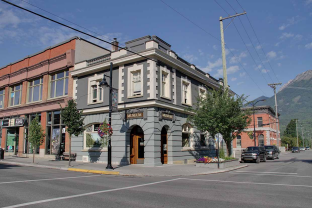
-The Fernie District Historical Society was founded in 1964 and is dedicated to preserving and presenting the history of Fernie by collecting and displaying photographs, artifacts and documents relating to Fernie's development. Homeless for the first 15 years, the Society struck an agreement with the Holy Family Church to use the vacant rectory behind the Church as a museum site.
-On August 4, 1979, coinciding with Fernie's Diamond Jubilee, the museum was officially opened. The rectory served as Fernie's museum for twenty years until 1999 when the Church realized that it would soon need the property for its own purposes. The museum was forced to close its doors but a temporary seasonal exhibit at the Arts Station celebrating Fernie's centenary in 2004 proved so popular that a new seasonal Museum was opened at the Fernie Mall on the corner of 2nd Ave & 4th St. This, in turn, was so popular that it remained open year-round, and the board of directors began earnestly seeking a more appropriate location.
-The City of Fernie purchased the former Home Bank Building on the corner of 2nd Ave and 5th street, and an agreement was reached for the Museum to occupy the space. The building had been used for many years as the offices of BC Hydro. A two-year program of renovations and repairs was undertaken, including stripping out much of the 1960s and 70's style fittings and fixtures, and restoring and replacing the original woodwork and trim. The Fernie Museum reopened in 2013, just prior to the 50th anniversary of the Fernie & District Historical Society.
-The Museum Gallery is a beautiful space and is also available for meetings, lectures, readings, and social gatherings.
VI.History
-While the slopes of the mountains are the present focus of economic activity, until comparatively recently residents of the area were more interested in the mountains' innards. The vast Crowsnest Coal Field lies just to the east of the city, and Fernie owes its origins to nineteenth-century prospector William Fernie, who established the coal industry that continues to exist to this day. Acting on pioneer Michael Phillips' twin discoveries of coal and the Crowsnest Pass a few years earlier, Fernie founded the Crows Nest Pass Coal Company in 1897 and established a temporary encampment near Coal Creek. The Canadian Pacific Railway arrived in the valley the following year, and a townsite emerged parallel to the railway line slightly north of the initial encampment, or "Old Town."
-On May 23, 1902, a coal mine explosion killed 109 miners at the Crow's Nest Coal Mining Company. The disaster, one of the worst mining accidents in Canadian history, is largely forgotten in Fernie and overlooked by local historians after more than a century. During World War One, an internment camp for prisoners of war was set up at rented premises in Fernie from June 1915 to October 1918.
-Underground coal mines were dug 10 kilometres (6.2 miles) away from the townsite in the narrow Coal Creek valley and until 1960 a small satellite community was known as Coal Creek stood adjacent to them. A variety of other mines were sunk into the coal fields in a fifty-kilometer radius in the following two decades. No mining was ever carried out in Fernie proper; coking of Coal Creek coal was carried out at the townsite, but otherwise, the town developed into an administrative and commercial centre for the burgeoning industry. Forestry played a smaller role in the local economy and a local brewery produced Fernie Beer from Brewery Creek (mountain spring water).
-Like most single-industry towns, Fernie endured several boom-and-bust cycles throughout the twentieth century, generally tied to the global price of coal. The mines at Coal Creek closed permanently by 1960 and the focus of mining activity shifted to Michel and Natal about twenty-five kilometres (16 miles) upriver, which sat on a more productive portion of the Crowsnest Coal Field. Kaiser Resources opened immense open-pit mines there in the 1970s to meet new metallurgical coal contracts for the Asian industrial market, predominantly for use in blast furnaces. Fernie would remain an important residential base for mine labour, along with the new communities of Sparwood and Elkford that sprang up much closer to these new mines. Today, Teck Resources operates all five open-pit mines, shipping out unit trains (often with more than 100 cars) along the Canadian Pacific Railway through Fernie to the Pacific Coast, where the coal is loaded onto freighters at Roberts Bank Superport in Delta.
VII.Other information
-Fernie is a true mountain community, revelling in Mother Nature's delights, a thriving cultural scene, the enthusiasm of a vibrant youthful population and a scenic, tranquil location in the heart of the Canadian Rocky Mountains.
-Cool, small-town charm: Fernie’s funky main street with its turn-of-the-century brick buildings framed by postcard-perfect mountains provides this rugged and unpolished little town with a unique charm.
-Mountain culture: From the pick-up trucks and mountain bikes that travel its streets, to the ski bums and guide shops that line them, Fernie’s distinct mountain culture is evident at almost every turn.
-Stunning scenery: Fernie is a magnificent outdoor setting from which to experience the beauty and majesty of the Canadian Rocky Mountains.
-Authentic and real: Fernie is a casual, comfortable, and laid-back place where a local community still thrives. A community first, destination second, Fernie is not a packaged experience for the mass tourist.
-Adventurous and outdoorsy: Fernie is a place where adventure seekers, mountain enthusiasts, and outdoor recreationists of all kinds come to experience the stunning natural surroundings and range of outdoor activities.
-Euphoric: Fernie is an escape from the hurried pace of everyday life. It provides euphoric experiences to its visitors and residents through unique moments of anticipation, achievement and the beauty of its natural surroundings.
-Down-to-earth: Fernie’s people are humble, honest, natural, and welcoming with a resiliency that stems from their hard-working roots.
-Enduring history: Fernie has a rich history that is alive and thriving to this day.
-Community-minded: Fernie’s people work together for the betterment of their town, its residents and its visitors. They take pride in their community and welcome visitors who share their values.
-In 1963 locally owned Fernie Snow Valley opened, laying the foundation for today’s resort by cutting runs, building lifts and creating the resort’s first on-mountain subdivision. Fuelled by enthusiastic residents, Fernie bid for the 1968 Winter Olympics and the region took its first steps in becoming a world-class resort. In 1998 the resort was purchased and was renamed Fernie Alpine Resort. The ski area was doubled with the construction of new lifts and building began on the alpine village at the base of the resort.
VIII.Contact information
-Government:
•City Mayor: Ange Qualliza
•Governing body: Fernie City Council
•MP: Rob Morrison (politician)
•MLA: Tom Shypitka
-Tourism Fernie Corporate Office:
•Hours of Operations: Monday - Friday 9:00am - 5:00pm (MST), except holidays.
•Box 1928, 102 Commerce Road, Fernie, British Columbia, Canada V0B 1M0
•Ph: 1-250-423-2037
-Website: https://www.fernie.ca/
